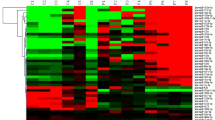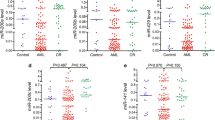Abstract
Myelodysplastic syndrome (MDS) is a clonal stem cell disorder characterized by ineffective hematopoiesis with a high risk of transformation to acute myeloid leukemia (AML). miRNAs function as tumor suppressors and oncogenes in various cancers and regulate the differentiation potential of hematopoietic stem and progenitor cells (HSPCs). It has been suggested that miRNAs may play an important role in progression of MDS. We analyzed bone marrow samples collected from MDS patients according to different risk stratification indicated by the International Prognostic Scoring System (IPSS). We demonstrated that miR-196b-5p was up-regulated in intermediate II and higher groups, and in secondary AML (s-AML) patients in particular (P < 0.01) compared with healthy controls, suggesting that the higher expression levels are associated with increased risk of the development of MDS. We observed changes in proliferation and apoptosis in MDS-L cells following transfection with miR-196-5p mimics or inhibitors. After up-regulating the expression of miR-196b-5p, proliferation of MDS-L cells was up-regulated, whereas apoptosis was down-regulated (P < 0.05). In contrast, down-regulation of miR-196b-5p expression decreased cell proliferation and increased apoptosis (P < 0.05). We concluded that over-expression of miR-196b-5p may be closely associated with the risk of transformation to leukemia in MDS patients.



Similar content being viewed by others
References
Visconte V, Tiu RV, Rogers HJ. Pathogenesis of myelodysplastic syndromes: an overview of molecular and non-molecular aspects of the disease. Blood Res. 2014;49(4):216–27.
Issa JP. Epigenetic changes in the myelodysplastic syndromes. Hematol Oncol Clin N Am. 2010;24(2):317–30.
Schemenau J, Balsus S, Anlauf M, Reinecke P, Braunstein S, Blum S, et al. Cellularity, characteristics of hematopoietic parameters and prognosis in myelodysplastic syndromes. Eur J Haematol. 2015;95(3):181–9.
Parker JE, Mufti GJ. The role of apoptosis in the pathogenesis of the myelodysplastic syndromes. Int J Hematol. 2001;73(4):416–28.
Shen L, Kantarjian H, Guo Y, Lin E, Shan J, Huang X, et al. DNA methylation predicts survival and response to therapy in patients with myelodysplastic syndromes. J Clin Oncol. 2010;28(4):605–13.
Will B, Zhou L, Vogler TO, Ben-Neriah S, Schinke C, Tamari R, et al. Stem and progenitor cells in myelodysplastic syndromes show aberrant stage-specific expansion and harbor genetic and epigenetic alterations. Blood. 2012;120(10):2076–86.
Adès L, Itzykson R, Fenaux P. Myelodysplastic syndromess. Lancet. 2014;383(9936):2239–52.
Nolte F, Hofmann WK. Myelodysplastic syndromes: molecular pathogenesis and genomic changes. Ann Hematol. 2008;87(10):777–95.
Bally C, Thepot S, Quesnel B, Quesnel B, Vey N, Deryfus F, et al. Azacitidine in the treatment of therapy related myelodysplastic syndromes and acute myeloid leukemia (t-MDS/AML): a report on 54 patients by the Groupe Francophone Des Myelodysplasies (GFM). Leukemia Res. 2013;37(6):637–40.
Lee RC, Feinbaum RL, Ambros V. The C. elegans heterochronic gene lin-4 encodes small RNAs with antisense complementarity to lin-14. Cell. 1993;75(5):843–54.
Bartel DP. MicroRNAs: genomics, biogenesis, mechanism, and function. Cell. 2004;116(2):281–97.
Hatfield S, Ruohola-Baker H. MicroRNA and stem cell function. Cell Tissue Res. 2008;331(1):57–66.
Castoldi M, Schmidt S, Benes V, Noerholm M, Kulozik AE, Hentze MW, et al. A sensitive array for microRNA expression profiling (miChip) based on locked nucleic acids (LNA). RNA. 2006;12(5):913–20.
Livak KJ, Schmittgen TD. Analysis of relative gene expression data using real-time quantitative PCR and the 2(−Delta Delta C (T)) method. Methods. 2001;25(4):402–8.
Hamano R, Miyata H, Yamasaki M, Kurokawa Y, Hara J, Moon JH. Overexpression of miR-200c induces chemoresistance in esophageal cancers mediated through activation of the Akt signaling pathway. Clin Cancer Res. 2011; 17(9):3029–38.
Buttke TM, McCubrey JA, Owen TC. Use of an aqueous soluble tetrazolium/formazan assay to measure viability and proliferation of lymphokine-dependent cell lines. J Immunol Methods. 1993;157(1–2):223–40.
Guo S, Lu J, Schlanger R, Zhang H, Wang JY, Fox MC, et al. MicroRNA miR-125a controls hematopoietic stem cell number. Proc Natl Acad Sci USA. 2010;107(32):14229–34.
Djuranovic S, Nahvi A, Green R. A parsimonius model for gene regulation by miRNAs. Science. 2011;331(6017):550–3.
Iwasaki H, Akashi K. Hematopoietic development pathways: on cellular basis. Oncogene. 2007;26(47):6687–96.
Doulatov S, Notta F, Laurenti E, Dick JE. Hematopoiesis: a human perspective. Cell Stem Cell. 2012;10(2):120–36.
O’Connell RM, Chaudhuri AA, Rao DS, Gibson WS, Balazs AB, Baltimore D. MicroRNAs enriched in hematopoietic stem cells differentially regulate long-term hematopoietic output. Proc Natl Acad Sci USA. 2010;107(32):14235–40.
Lujambio A, Lowe SW. The microcosmos of cancer. Nature. 2012;482(7385):347–55.
Sokol L, Caceres G, Volinia S, Alder H, Nuovo GJ, Liu CG, et al. Identification of a risk dependent microRNA expression signature in myelodysplastic syndromes. Br J Haematol. 2011;153(1):24–32.
Bousquet M, Quelen C, Rosati R, Mansat-De Mas V, La Starza R, Bastard C, et al. Myeloid cell differentiation arrest by miR -125b-1 in myelodysplastic syndromes and acute myeloid leukemia with the t(2;11)(p21;q23) translocation. J Exp Med. 2008;205(11):2499–506.
Hussein K, Theophile K, Büsche G, Schlegelberger B, Göhring G, Kreipe H, et al. Aberrant microRNA expression pattern in myelodysplastic bone marrow cells. Leukemia Res. 2010;34(9):1169–74.
Pons A, Nomdedeu B, Navarro A, Gaya A, Gel B, Diaz T, et al. Hematopoiesis-related microRNA expression in myelodysplastic syndromes. Leuk Lymphoma. 2009;50(11):1854–9.
McGlinn E, Yekta S, Mansfield JH, Soutscjel J, Bartel DP, Tabin CJ. In ovo application of antagomiRs indicates a role for miR-196 in patterning the chick axial skeleton through Hox gene regulation. Pro Natl Acad Sci USA. 2009; 106(44):18610–5.
Marcucci G, Mrózek K, Radmacher MD, Garzon R, Bloomfield CD. The prognostic and functional role of microRNAs in acute myeloid leukemia. Blood. 2011;117(4):1121–9.
Danen-van AA, Kuipers JE, Arentsen-Peters S, Schotte D, de Haas V, Trka J, et al. Differrentially expressed microRNAs in cytogenetic and molecular subtypes of pediatric acute myeloid leukimia. Pediatr Blood Cancer. 2012;58(5):715–21.
Wang Y, Li Z, He C, Wang D, Yuan X, Chen J, et al. MicroRNAs expression signatures are associated with lineage and survival in acute leukemia. Blood Cells Mol Dis. 2010;44(3):191–7.
Popovic R, Riesbeck LE, Velu CS, Chaubey A, Zhang J, Achille NJ, et al. Regulation of mir-196b by MLL and its overexpression by MLL fusions contributes to immortalization. Blood. 2009;113(14):3314–22.
Mitchell PS, Parkin RK, Kroh EM, Fritz BR, Wyman SK, Pogosova-Agadjanyan EL, et al. Circulating microRNAs as stable blood-based markers for cancer detection. Proc Natl Acad Sci USA. 2008;105(30):10513–8.
Merritt WM, Bar⁃Eli M, Sood AK. The dicey role of Dicer: implications for RNAi therapy. Cancer Res. 2010;70(7):2571–4.
Kumar MS, Pester RE, Chen CY, Lane K, Chin C, Lu J, et al. Dicer1 functions as a haploinsufficient tumor suppressor. Genes Dev. 2009;23(23):2700–4.
Raaijmakers MH, Mukherjee S, Guo S, Zhang S, Kobayashi T, Schoonmaker JA, et al. Bone progenitor dysfunction induces myelodysplasia and secondary leukaemia. Nature. 2010;464(7290):852–7.
Fu CM, Chen ZX, Liu DD, Zhang J, Pan JL, Liang JY. Clonal origin and evolution of myelodysplastic syndromes analyzed by dysplastic morphology and fluorescence in situ hybridization. Int J Hematol. 2015;101(1):58–66.
Author information
Authors and Affiliations
Corresponding author
Ethics declarations
Funding
This work has been supported by a grant from the National Natural Science Foundation of China (Nos. 81560028 and 81160072), Natural Science Foundation of Guangxi Province (No. 2010GXNSFB 013064).
Conflict of interest
The authors have no conflict of interest to disclose.
Additional information
J. Wen and Y. Huang contributed equally to this work.
About this article
Cite this article
Wen, J., Huang, Y., Li, H. et al. Over-expression of miR-196b-5p is significantly associated with the progression of myelodysplastic syndrome. Int J Hematol 105, 777–783 (2017). https://doi.org/10.1007/s12185-017-2201-9
Received:
Revised:
Accepted:
Published:
Issue Date:
DOI: https://doi.org/10.1007/s12185-017-2201-9




